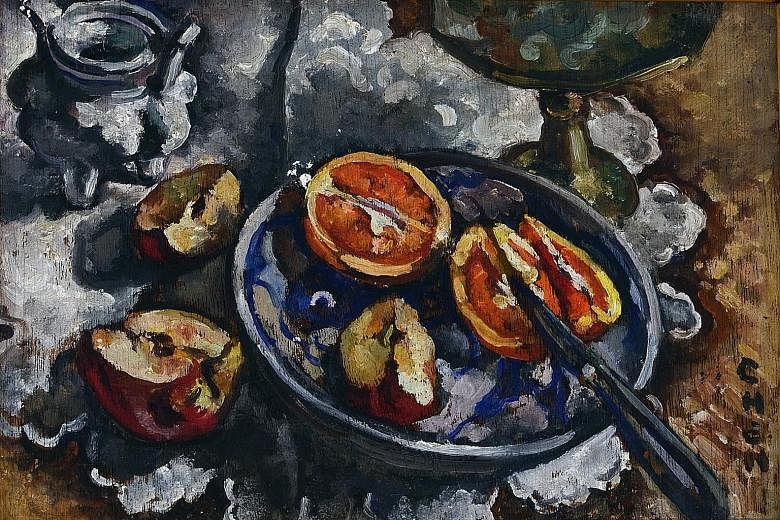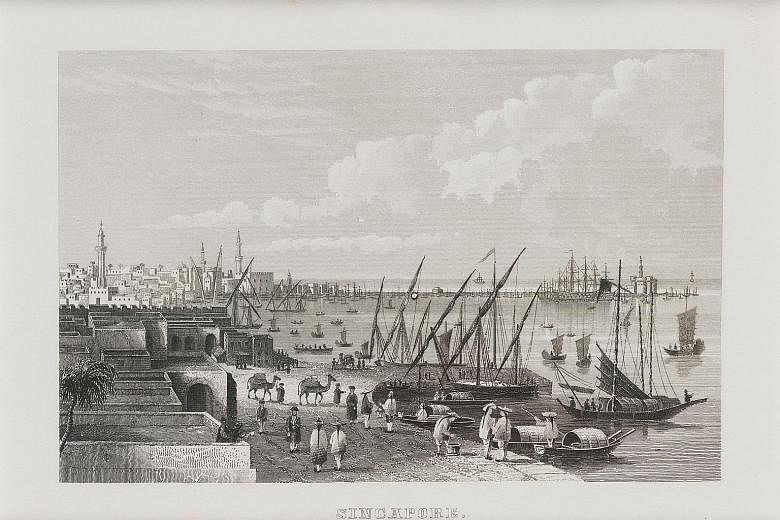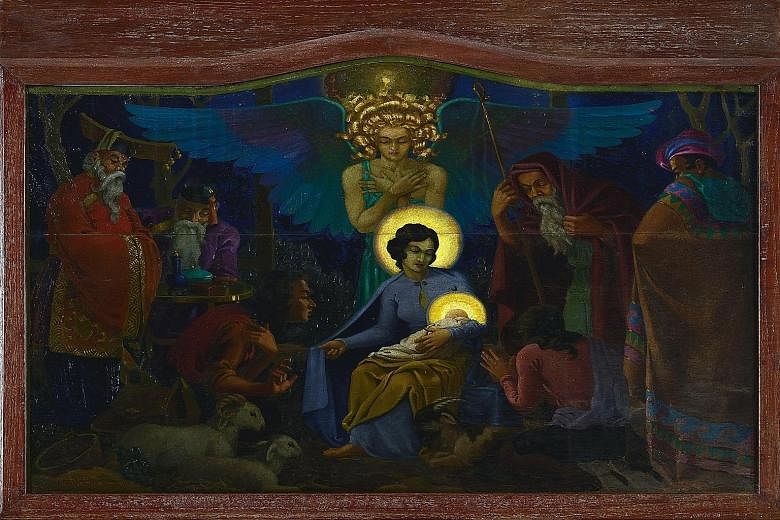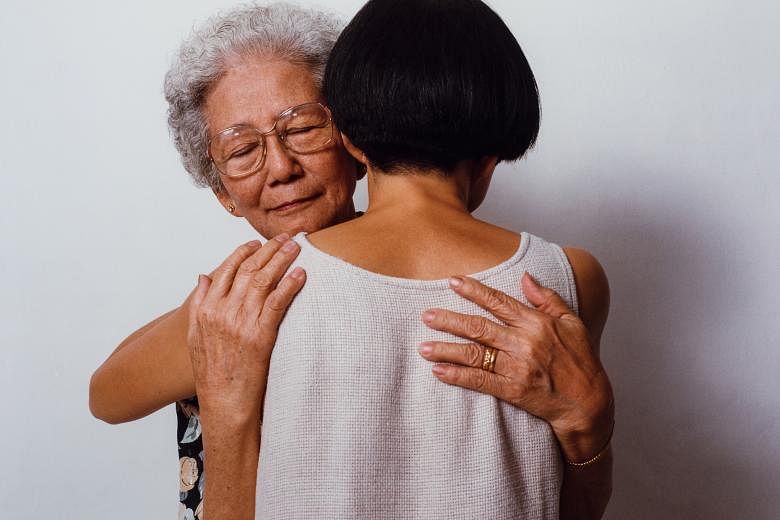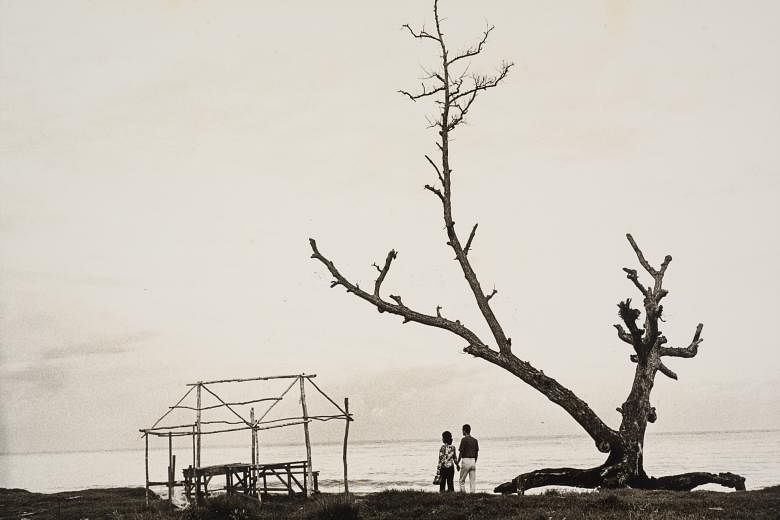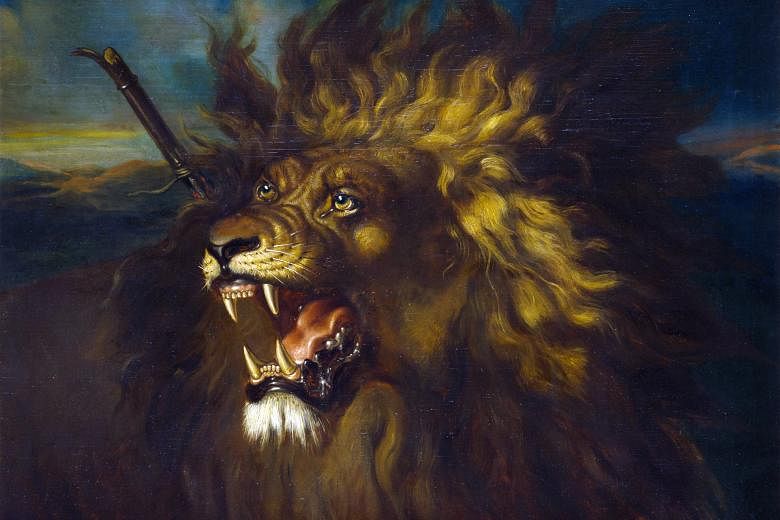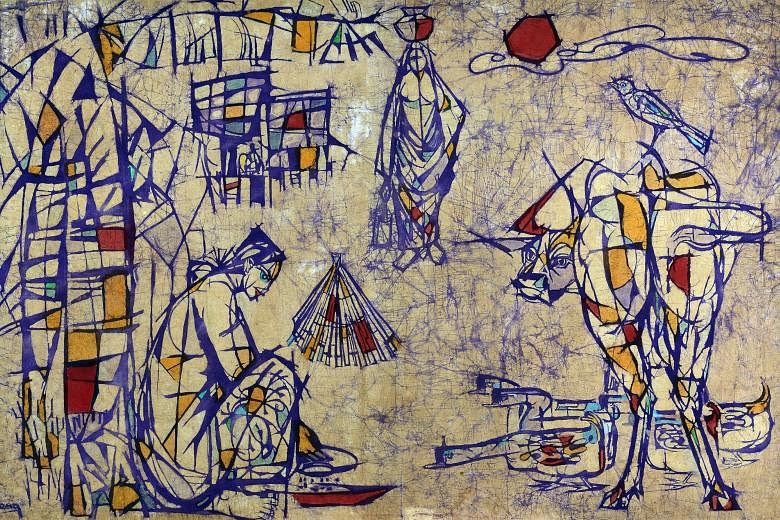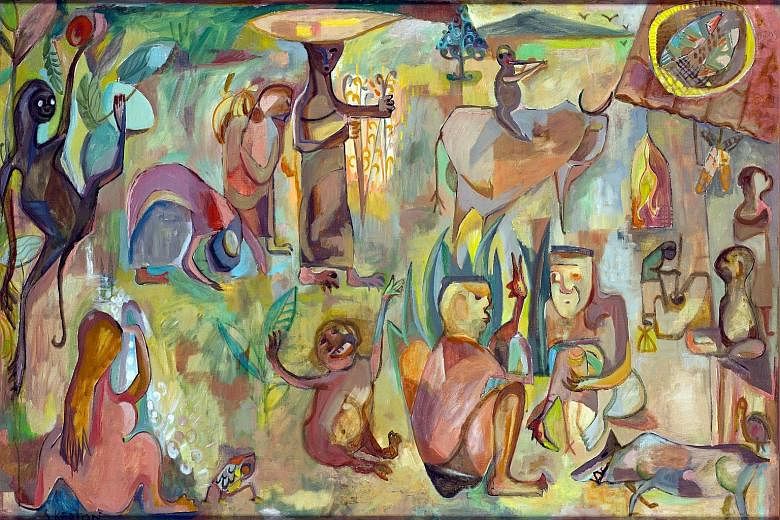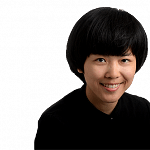DBS SINGAPORE GALLERY
1. STILL LIFE WITH CUT APPLE AND ORANGE, 1928 to 1930
By Georgette Chen, oil on panel, 26cm by 34cm
Rich colours and lively brushwork give this still life a commanding presence and the dynamic composition - the fruit knife has its blade thrust into a cut orange and its handle balanced on the rim of the bowl, extending right to the edge of the painting - imbues it with a sense of immediacy.
The work may recall the still life of French artist Cezanne - Chen studied art in Paris in the 1920s - but it carries her own flair, which includes incorporating a Chinese-inspired vessel in the composition.
Chen was a Singapore pioneer of the Nanyang style of art that marries Chinese and Western techniques and styles of painting.
2. SINCAPORE (SINGAPORE), 1840s
Artist unknown, lithograph, 10.1cm by 16cm
At first glance, this palm-sized print of Singapore is like other
early representations of the island - a busy port settlement at the crossroads of maritime trade.
But look again and it opens up to a fantastical view of a place with camels by the port and architecture evocative of the Middle East, bringing to mind Western artistic representations of the Orient.
3. EPIPHANY, 1942
By Richard Walker, oil on panel, 71cm by 98.6cm
This panel, depicting the nativity scene, hangs above eye level, perhaps as a nod to its original intention as an altarpiece. The angel's radiance and the luminous halos of Virgin Mary and Jesus Christ, however, beckon viewers and a closer look yields surprises such as a wise man from the East (on the left) dressed in a style that echoes Chinese imperial fashion. That this alluring, ingenious painting of a saviour born to die was made by Walker, a British art educator, during the Japanese Occupation while he was interred in Changi prison, makes it all the more remarkable and poignant.
4. ANOTHER WOMAN, 1996 to 1997
By Amanda Heng, C-print on paper, 75.4cm by 100.9cm
In a room full of contemporary art from Singapore, three pictures of Singapore artist Heng and her mother stand out for their emotional tenderness. They are part of a two-year series of installation, performance and photographic works she did to explore the female role and identity through her relationship with her mother, which had been shaped by a patriarchal family. This project, which grew from a portrait request by her ageing mother in anticipation of her death and funeral, shows mother and daughter connecting through art.
5. SOLITUDE, 1960 to 1970
By Chua Tiag Ming, photograph, 22.5cm by 29.9cm
This monochromatic picture, photographed during a politically and socially turbulent time in Singapore, is simultaneously subdued and melodramatic.
A couple, with their backs to the camera and standing hand-in-hand on an abandoned beach, is flanked by a skeletal hut on one side and an imposing, gnarled tree with bare branches on the other.
Nothing quite happens in this picture, yet it is profoundly evocative and carries a whiff of anticipation in a desolate landscape.
Chua was a skilled Singaporean photographer active in the 1960s and 1970s, who adopted a realist approach to picture-making.
UOB SOUTHEAST ASIA GALLERY
6. WOUNDED LION, 1839
By Raden Saleh, oil on canvas, 88cm by 108.5cm
This painting of the head of a wounded lion baring its teeth in anguish and defiance hangs on an adjacent wall to another realistic painting by Saleh.
Forest Fire (1849), which measures 300cm by 396cm, threatens to overshadow all other works in the room with its monumental scale and dramatic scene of wild animals chased by fire.
This smaller piece, however, forces the viewer to confront head-on the moment when life meets death, making the encounter more intense.
Saleh, a Javanese artist who trained in Europe and was influenced by Romanticism - which emphasised imagination and emotional extremes and its artists often depicted animals as metaphors for human behaviour - was a forerunner of modern art in Indonesia.
7. MORNING, 1960 to 1963
By Chuah Thean Teng, batik on cloth, 112cm by 173cm
Chuah's rustic painting of rural village life, rendered in bold sketch lines and coloured geometric shapes, stands out for using batik as a medium for fine art.
The artist is widely regarded as being among the first in Malaysia to blend Western-style painting with the traditional South-east Asian technique of wax-resist dyeing to create a visual language unique to the region.
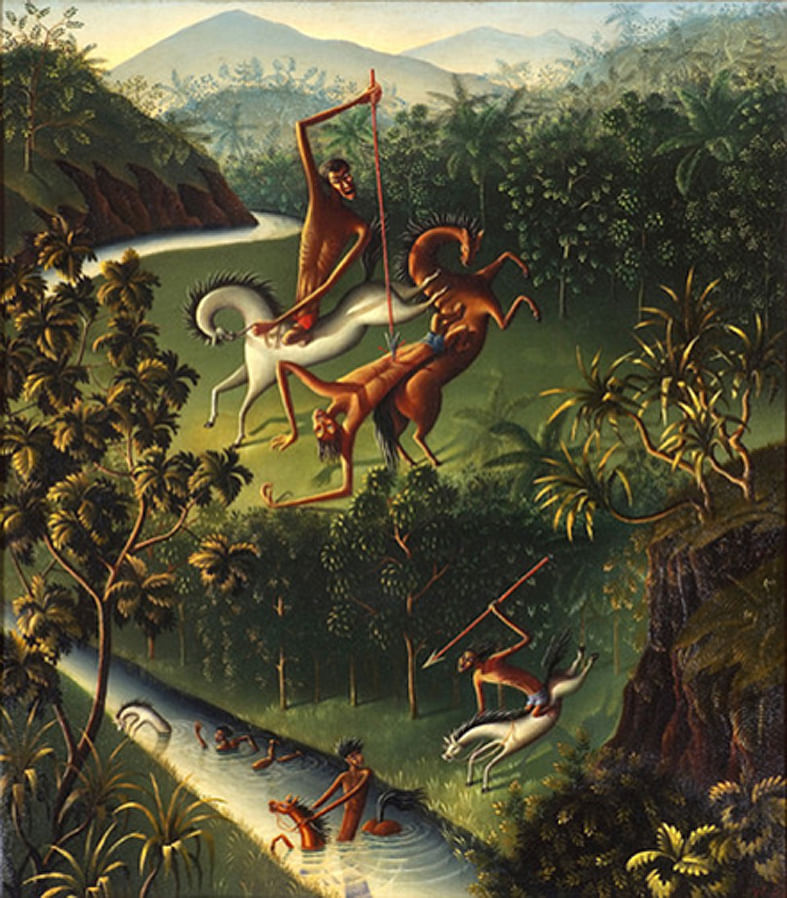
8. BALINESE LEGEND, 1929
By Walter Spies, oil on canvas, 80cm by 65cm
The legend that this work might refer to, if there is one, is not known. But there is no mistaking the painting's folkloric charm and the verdant landscape of Bali, which are vividly captured by Spies, a German artist who settled in Bali at the age of 27.
His creative synthesis of Balinese subject and Western painting technique is also seen in the stylised human figures and their theatrical gestures, which recall the artistic style of Balinese puppetry.
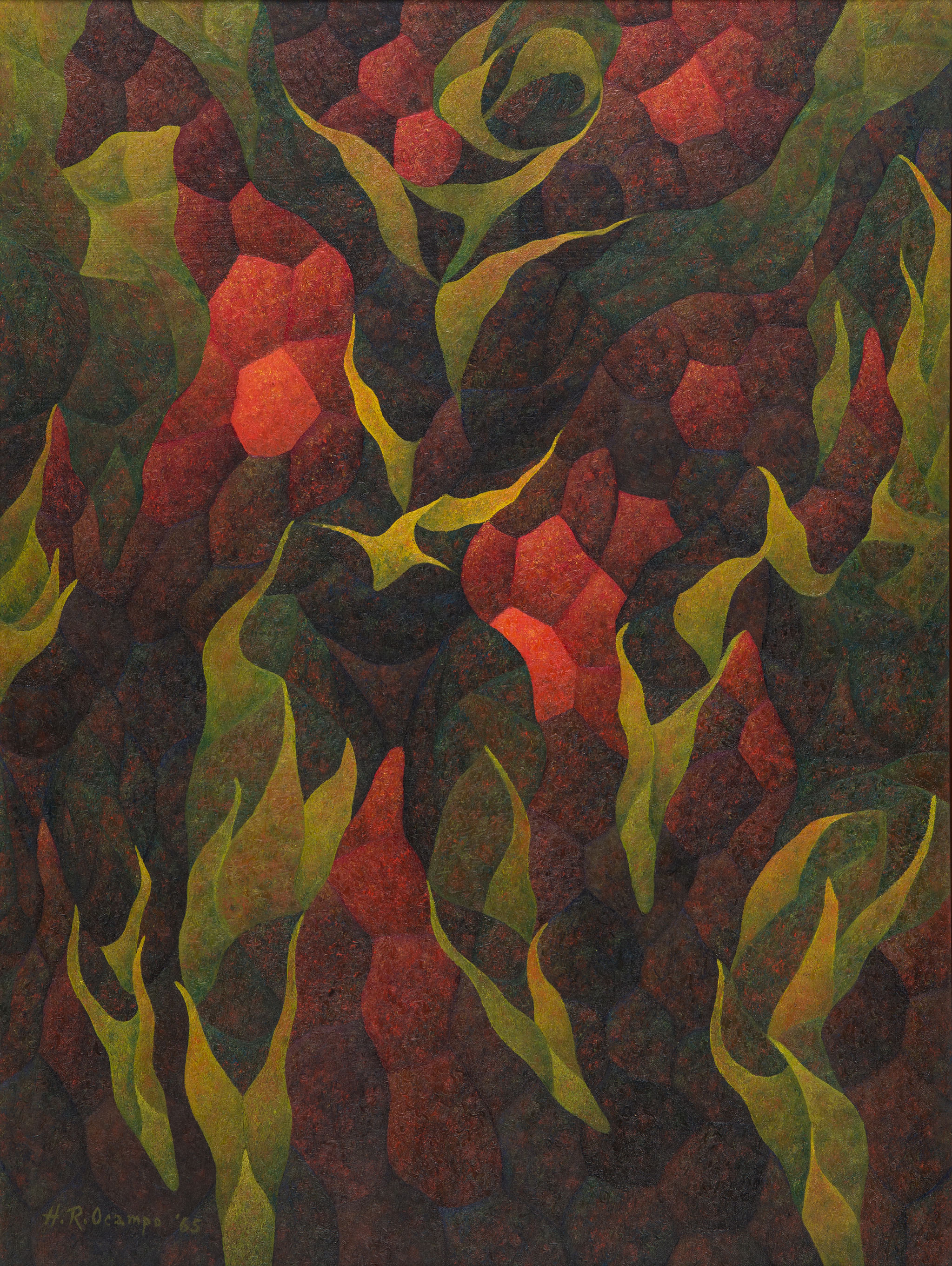
9. DANCING MUTANTS, 1965
By Hernando R. Ocampo, oil on canvas, 101.8cm by 76cm
This abstract painting shows organic forms in vibrant hues of red and green. The biomorphic shapes have a visceral quality that makes the painting profoundly hypnotic.
Ocampo was a Filipino artist working as part of the country's post-war Neo-Realist movement, which sought to break away from figurative pre-war art and build a new, modern visual vocabulary. His mutant series responds to the atomic age following World War II.
10. KEHIDUPAN DI KAMPUNG (VILLAGE LIFE), undated
By Sudjana Kerton, oil on canvas, 105cm by 180cm
Indonesian artist Kerton's sweeping view of village life charms with its lyrical palette and spirited expression of communal living - villagers farming, cooking and bartering and animals at play.
Kerton, in highlighting these everyday vignettes, rendered in a loosely cubist fashion, imbues the quotidian with a mythical quality and celebrates the ordinary and the simple life.
